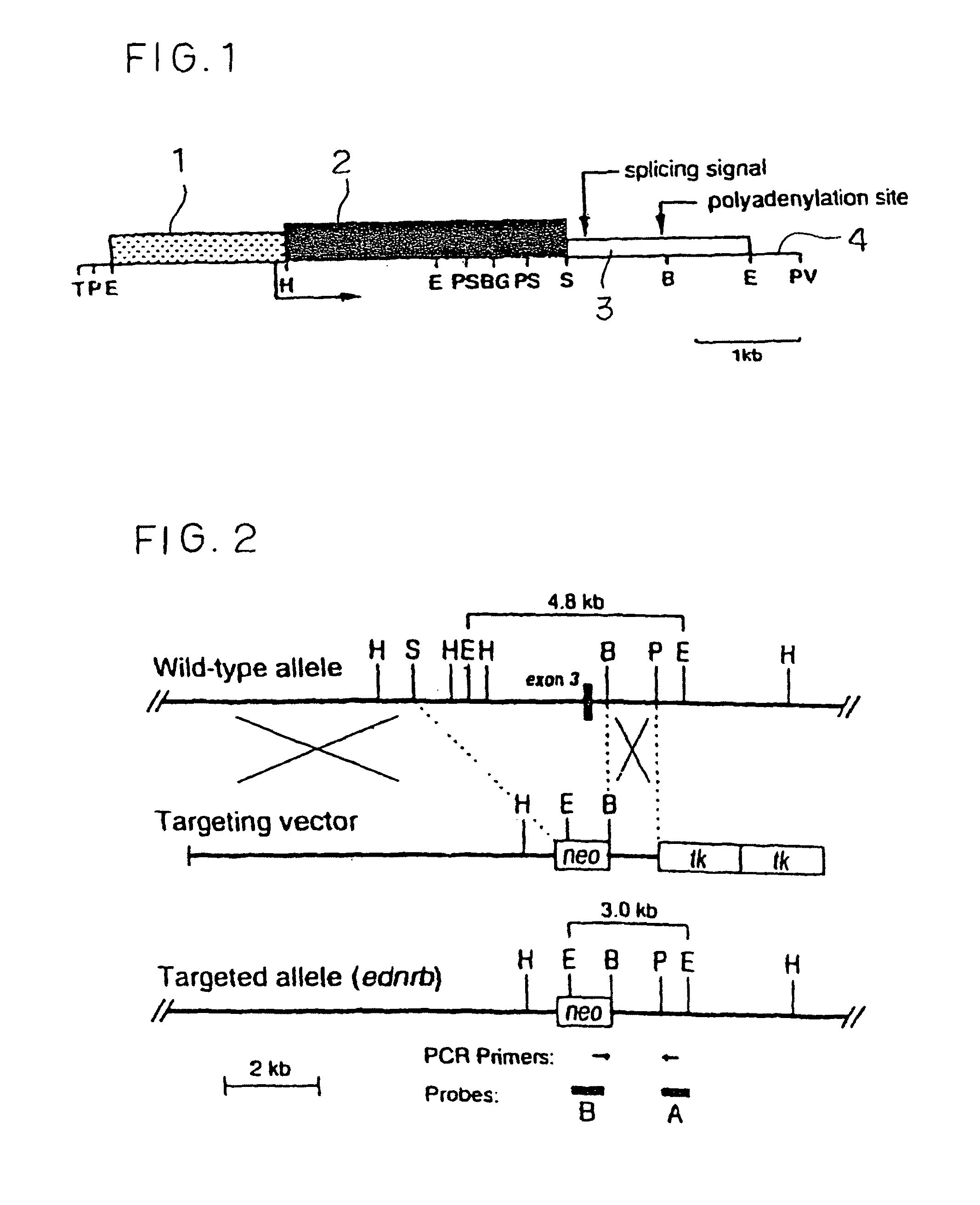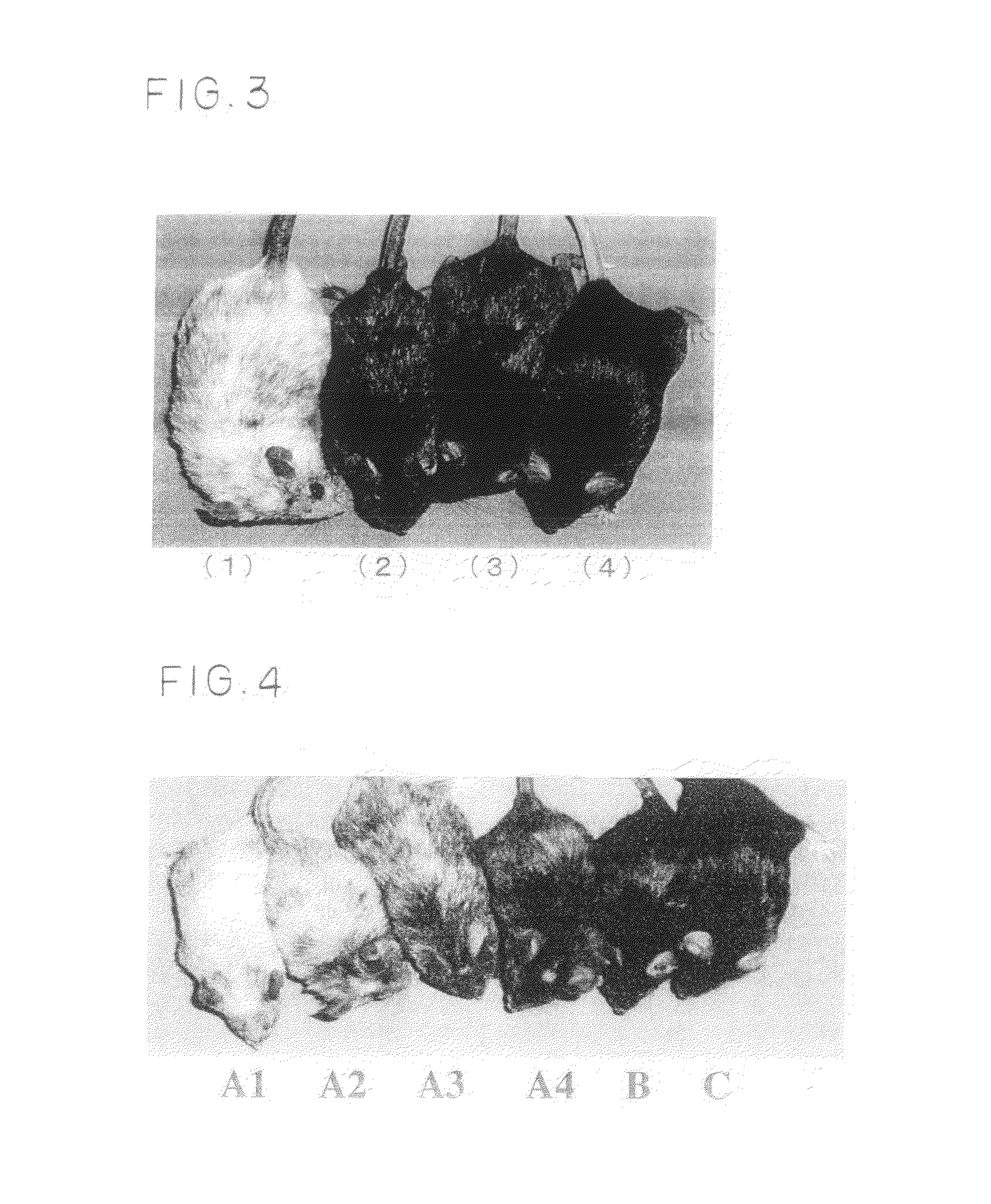Model animal causing the white hair development and methods relating thereto
a technology of white hair and model animals, applied in the field of model animals causing white hair development, can solve the problems of insufficient user satisfaction for hair dying, insufficient white hair development, so as to suppress white hair development, promote white hair development, and prevent white hair developmen
- Summary
- Abstract
- Description
- Claims
- Application Information
AI Technical Summary
Benefits of technology
Problems solved by technology
Method used
Image
Examples
example 1
Preparation of MT / RET Transgenic Mouse
[0100]The preparation of the MT-RET-transgenic mouse described below in Example 1 was essentially done, according to the method in the Literature 1. Herein, the mouse of the line 304 / B6 as described below is described in the following Literature 6.
[Literature 6] Kato M, Takahashi M, Akhand A A, Lie W, Dai Y, Shimizu S, Iwamoto T, Suzuki H, Nakashima I,
“Transgenic mouse model forskin malignant melanoma” Oncogene, 1998 Oct. 8; (14); 1885-8.
(Plasmid Construction)
[0101]A 1.7-kb EcoRI-Bg / II fragment containing the murine metallothionein I (MT-I) promoter was scissored out from the plasmid pMK (Brinster et al., 1981) and subcloned into the polylinker site of the plasmidpUC8. Then, a 340-bp PvuII-Hind III fragment corresponding to the SV-40-controlling region in the plasmidpSV2RETT (Takahashi et al., 1988) was replaced with the MT-I promoter-containing PvuII-Hind III fragment subcloned in pUC8, to construct a plasmid pMT / RET. The plasmid pMT / RET contai...
example 2
Preparation of Ednrb Gene-Targeting Mouse
[0105]The preparation of the Ednrb gene-targeting mouse in accordance with the Example is done according to the method of the Literature 2 as described above. The summary is described hereinbelow.
[Construction of Gene Targeting Vector]
[0106]As the “wild-type allelle” in FIG. 2, a map including the Ednrb exon 3 in the murine genome DNA is shown. The Roman symbols in the map, such as H, S and B represent recognition sites of specific restriction enzymes, as follows. B: BgIII; E: EcoRI; H: HindIII; S: SalI; P: PstI.
[0107]As “the targeting vector” in FIG. 2, a vector for recombination as constructed for targeting the Ednrb gene of the murine ES cell is shown. The vector for recombination is prepared by replacing a 4.2-kb region containing the Ednrb exon 3 of the murine genome DNA cloned with a neomycin-resistant cassette [represented as “neo”] and then conjugating the tk cassette (simple herpes virus thymidine kinase) at the 3′ end of the resulti...
example 3
[0113]The MT / RET-transgenic mouse of the line 304 / B6 as obtained in Example 1 (with the activated RET gene genetically inserted therein in a hetero form) was mated with the Ednrb gene-targeting mouse obtained in Example 2 (with deficiency in the Ednrb gene in a hetero form).
[0114]Via the mating, it is theoretically suggested that F1 generations with the following four gene types described below in (1) through (4) may be obtained.
(1) RET / +·Ednrb(+ / −): the gene type where the activated RET gene is inserted genetically in a hetero form while the Ednrb gene is deficient in a hetero form.
(2) RET / +·Ednrb(+ / +): the gene type where the activated RET gene is inserted genetically in a hetero form while the Ednrb gene is not deficient.
(3) + / +·Ednrb(+ / −): the gene type where the activated RET gene is never inserted while the Ednrb gene is deficient in a hetero form.
(4) + / +·Ednrb(+ / +): the gene type where the activated RET gene is never inserted while the Ednrb gene is never deficient.
[011...
PUM
| Property | Measurement | Unit |
|---|---|---|
| color | aaaaa | aaaaa |
| white hair development | aaaaa | aaaaa |
| structure | aaaaa | aaaaa |
Abstract
Description
Claims
Application Information
 Login to View More
Login to View More - R&D
- Intellectual Property
- Life Sciences
- Materials
- Tech Scout
- Unparalleled Data Quality
- Higher Quality Content
- 60% Fewer Hallucinations
Browse by: Latest US Patents, China's latest patents, Technical Efficacy Thesaurus, Application Domain, Technology Topic, Popular Technical Reports.
© 2025 PatSnap. All rights reserved.Legal|Privacy policy|Modern Slavery Act Transparency Statement|Sitemap|About US| Contact US: help@patsnap.com


